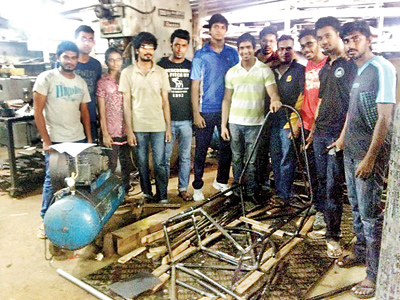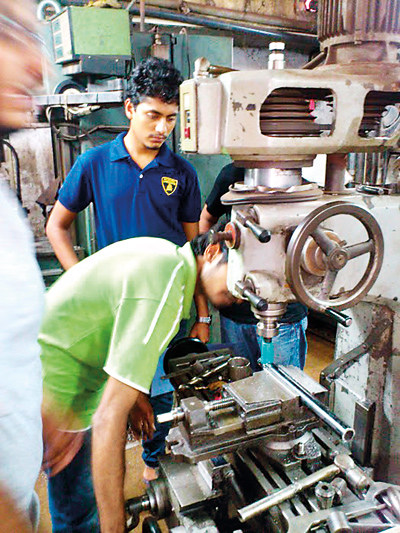Revving up to hit the fast lane
When Rajive Wisidagama and Kelasha Withanapathirana were invited to try their hand at taking a pro-kart for a spin, things didn’t end too well. The tyres screeched, rubber was burnt, and Rajive crashed into an embankment.
“Driving is not our thing,” laughs Kelasha. What really interests them is the engineering marvels of a racing machine. The third-year mechanical engineering students at the University of Moratuwa know they have the potential to build a racing car from scratch.

A group of Moratuwa Uni engineering students are on an exciting maiden mission, to build a racing car for Europe’s renowned Formula Student Competition to be held in Britain next year
Their dream was given wings when a mission – initially worked on by their senior batch- was handed over to them. The challenge: to create a Formula One car.
The car will be an entry for the Formula Student Competition 2016 -dubbed Europe’s most established educational motorsport competition- hosted by the IMechE (Institution of Mechanical Engineers), in the United Kingdom. More than 114 teams from 33 countries, with up to 3000 students will be taking part in next year’s competition, to be held at the world famous Silverstone track.
“The Formula Student competition brings the best engineering students from around the world to one stage and we find ourselves privileged to be there,” Kelasha chips in, adding that this will be the very first time a team from Sri Lanka will be taking part.
Essentially, the competition is one where engineering students are challenged to design and build a single-seat racing car in order to compete in both static and dynamic events, which demonstrate their understanding and test the performance of the vehicle.

Kelasha and Rajive had to assemble the team. What transpired next brings scenes from an Avengers movie to mind as both of them went around the university, head-hunting individuals who would make up their dream team.
“We had to pick people who were good at building individual components of the car,” says Kelasha. The chosen ones were soon given a name: Team Shark comprising eight specialists, with about 60 other members to handle the overall processes.
Rukmal Liyanage handles a pivotal aspect of the car – the engine. “The engine is the heart of the car and my job is to make sure that we had an engine that can rocket the car to a maximum speed of a 140 kmph,” says Rukmal.
Having been fascinated by motorbikes ever since he was a child, Rukmal knew that a Honda CBR engine (yes.. the kind that sounds like a nightmare every time it passes by) was perfect for the job.
“The IMechE had given us certain specifications and we had to abide by them.” The ‘formula’, designated in the name itself, refers to a set of rules, to which all participants’ cars must conform. “The engine we picked was a 600cc, 4 cylinder one, but I had to reduce the inlet diameter in order to meet specifications,” he explains.
The power they compromised with this move was accounted for by introducing a supercharger, which is an air compressor that increases the pressure of air supplied to the engine.
This gives the engine more oxygen, letting it burn more fuel and do more work, thus increasing power.
Rajive himself spearheaded the design department, and much like any other car designer he had three things in mind – aerodynamics, weight and performance.
“We initially thought of using aluminium to build the chassis as it would significantly reduce weight and give us more strength.” Sadly, the lack of expertise in aluminium welding for a specialized job such as this meant that they had to hack this notion and look for other options.
The team settled on Tungsten Inert Gas welding (TIG) and went about creating the chassis and body accordingly. Rajive however is miffed at not being able to use aluminium.
“It’s his thing. He always pushes for the best and puts me in trouble,” laughs Sajith Edirisinghe, who heads Finance and Management which can be as challenging as the engineering that goes into it.
“We’re aiming at restricting our total budget to Rs. 1.8 million. This sounds like a hefty figure, but on average the foreign teams spend an equivalent of about Rs. 8 million on their cars,” Sajith tells us.
Most of their funding came from fundraisers held within the university, but the team hopes to venture out seeking sponsors in the near future.
Managing the team is Chathura Semasinghe. “The Formula Student competition is not entirely about the process of making the car, it’s also about presentation,” says Chathura. In fact, out of the 600 points a car will be judged on, 150 is allocated for documentation.
The criteria is based on three pillars – fuel economy, lap-timing and management of resources. “I think we naturally become good at management when the resources at hand become restricted,” says Chathura, adding that while Team Shark may not have the luxury of the best materials to make use of, their intuition helps them make the most of what they have.
Praneeth Weerathunga is tasked with rebuilding a steering column that would fit in the centre of the car. “Generally cars are either left or right-hand driven, however the steering column of a Formula One car should sit in the middle,” explains Praneeth.
The team then went on to build the space frame, a truss-like, lightweight rigid structure constructed from interlocking struts in a geometric pattern. Team Advisor and Mechanical Engineering lecturer, Sasiranga De Silva’s expertise is omnipresent in overseeing Team Shark and the team is quick to acknowledge the wealth of technical help gained by the university.
Right now though, the team is caught up between frequent trips to Panchikawatte -where they dig up a daily treasure of spare parts- and to the Advanced Engineering workshop in Delkanda where the chassis is currently being welded out.
This is where the team gets their hands dirty with all the cutting and grinding. “Since welding is a specialized skill, that’s the only thing we can’t do. Everything else is done entirely by us,” says Kelasha.
The only girl on the core team, Sachitra Atapattu feels privileged to be a part of the gritty mechanical environment. “Although most of my work was in the design department, there’s a lot that I’m doing with the actual cutting and grinding,” she says.
Nushen Senevirathna, better known as the ‘Chief Engineer’ by the team, adds that this project helps them put into practice every module of engineering they’ve learnt from the university so far, and that hands-on projects as such should be encouraged in Sri Lanka.
“There’s vast potential in the country, but the only thing stopping us from surging forward is the funding.”
Surprisingly, none of the team members is an active follower of the Formula One circuit. A lot of thinking goes into answering who might be their favourite Formula One driver, some even draw a blank, but there’s plenty of chirp when asked what their favourite automobile is.
“Tesla. They’re really up there in terms of the future of engineering,” they reply in unison. Team Shark is operating on the same premise it seems: less fanfare and more work.


